Posted by: Northwest Eye in General on October 24, 2025
Overview
If you are living with keratoconus, you might be feeling overwhelmed by the challenges it brings to your vision. It’s completely understandable to seek solutions that can help improve your quality of life. Fortunately, there are several effective treatments available that can significantly enhance your visual clarity.
Options such as:
- Corneal cross-linking
- Intracorneal ring segments
- Customized contact lenses
- Corneal transplant surgery
are designed with your individual needs in mind. Each treatment utilizes advanced technology to address your specific situation, ensuring that you receive the most appropriate care.
We understand that navigating these choices can be daunting, but rest assured, you are not alone on this journey. Many patients have found comfort and clarity through these treatments, and we are here to support you every step of the way.
As you consider these options, remember that your feelings and concerns are valid. It’s common to feel anxious about what lies ahead, but with the right information and support, you can make informed decisions that align with your needs. We encourage you to reach out and discuss these treatments with your healthcare provider, who can guide you toward the best path for your recovery.
Introduction
Advancements in keratoconus treatments have ushered in a new era of hope for individuals grappling with this progressive eye condition. We understand that facing such a challenge can be daunting, but as the market for corneal care expands, patients now have access to a diverse range of innovative solutions designed to enhance vision and improve quality of life. However, it’s common to feel overwhelmed with so many options available. How can one navigate these complexities to find the most effective path forward?
This article delves into ten effective keratoconus treatments, exploring their benefits and offering insights into how they can help restore clarity and comfort to those affected. We are here to help you through this process, ensuring you feel supported every step of the way.
Northwest Eye: Comprehensive Keratoconus Treatment Options
Northwest Eye is at the forefront of addressing corneal conditions by offering a comprehensive range of keratoconus treatments that are carefully tailored to meet the unique needs of each patient. With over 50 years of experience, the clinic utilizes advanced technology and innovative methods to provide effective solutions for eye conditions. We understand that each patient’s journey is personal; therefore, our patient-focused approach ensures that every care plan is customized to address the specific challenges faced by individuals with these conditions. From initial diagnosis to ongoing management, Northwest Eye is dedicated to enhancing vision and improving the quality of life for those affected.
Recent advancements in keratoconus treatments have significantly improved patient outcomes. The corneal condition care market, valued at approximately USD 280.36 million in 2022, is projected to grow at a CAGR of 4.2% from 2023 to 2030, driven by increased awareness and technological innovations. Esteemed eye specialists emphasize the importance of personalized care, with Dr. Steven Greenstein stating, “Recognizing those objectives enables me to align care alternatives with the individual.” This tailored approach not only addresses the medical aspects of keratoconus treatments but also provides emotional support, particularly for younger individuals facing their first chronic illness.
At Northwest Eye, our commitment to using the latest advancements ensures that patients benefit from innovative solutions, including keratoconus treatments such as corneal cross-linking and personalized contact lenses. These options not only stabilize the condition but also enhance visual clarity, allowing many individuals to achieve unaided vision. Our dedication to comprehensive eye care services is reflected in our effective keratoconus treatments, which prioritize both the physical and emotional well-being of our patients and ultimately foster a supportive community for those navigating the challenges of corneal conditions. With multiple locations, including the Minnetonka Surgery Center, Northwest Eye is well-equipped to provide accessible and expert care for everyone.
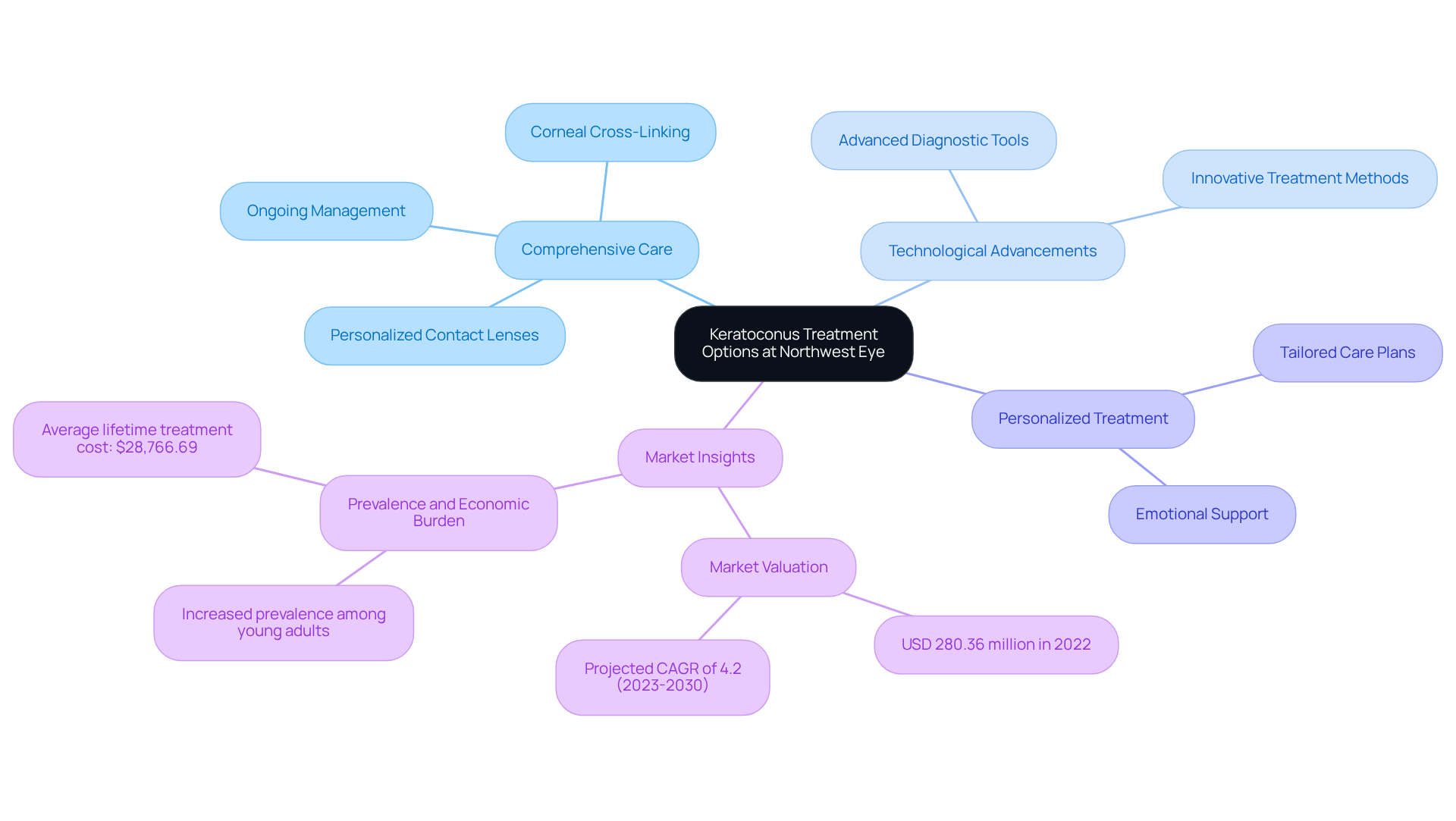
Corneal Cross-Linking (CXL): Strengthening the Cornea
Corneal Cross-Linking (CXL) is one of the keratoconus treatments that is a minimally invasive procedure designed to strengthen the cornea for individuals facing a progressive condition that leads to thinning and abnormal curvature. We understand that this situation can be concerning, and it’s important to know that this innovative treatment offers hope.
The process involves applying riboflavin (vitamin B2) drops to the cornea, followed by exposure to ultraviolet light. This combination facilitates the formation of new bonds between collagen fibers, enhancing corneal stability. It’s common to feel apprehensive about such procedures, but CXL not only halts the progression of corneal ectasia but also significantly improves visual clarity.
Recent studies have shown that:
- 84.1% of individuals who underwent CXL maintained good visual acuity in their better eye after ten years, compared to 72.8% in untreated groups.
- This success rate is reassuring.
- Moreover, accelerated CXL has demonstrated a failure rate of only 14.7%, further emphasizing its effectiveness.
As part of your journey, specially fitted contact lenses may also be suggested as a preliminary treatment option for corneal irregularity. This makes CXL an essential choice among keratoconus treatments for managing your condition, providing long-term stability and enhanced vision. We are here to help you through this process, ensuring you feel supported every step of the way.
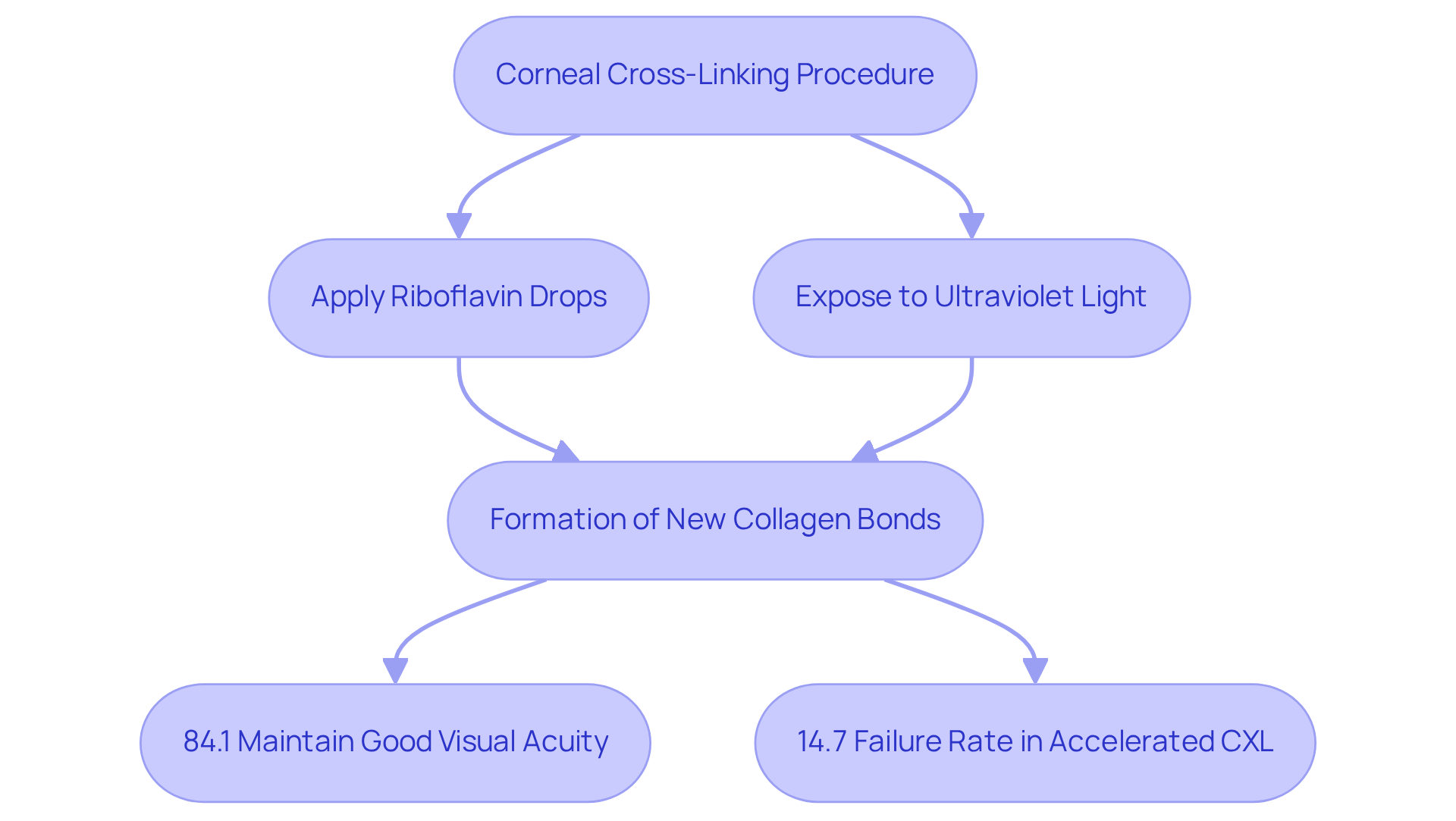
Intracorneal Ring Segments (ICRS): Reshaping the Cornea
Intracorneal Ring Segments (ICRS) are innovative, crescent-shaped devices that can be surgically inserted into the cornea to help flatten and reshape it, significantly enhancing visual clarity for those experiencing corneal irregularities. We understand that facing such challenges can be daunting, but this minimally invasive procedure involves creating precise channels in the cornea for segment insertion, effectively reducing steepness and improving vision.
For individuals with moderate keratoconus who may not be suitable candidates for other keratoconus treatments or are seeking additional vision correction, ICRS provides a reassuring solution. Studies have shown that ICRS can enhance contact lens tolerance and lower the chances of needing more invasive surgical options. It’s common to feel uncertain about the future, but the outcomes for individuals after ICRS implantation have been promising, with uncorrected distance visual acuity (UDVA) improving from a median of 20/400 to 20/200 post-surgery.
Ophthalmologists have observed that ICRS not only improves vision but also has the potential to delay or prevent the need for corneal transplantation in more advanced cases. As one specialist shared, ‘ICRS implantation signifies an effective and secure treatment choice for visual enhancement in individuals with corneal ectasia.’ We are here to help you through this process, and it’s important to know that among the keratoconus treatments, ICRS stands out as a valuable option, providing hope and an improved quality of life for those affected by this condition.
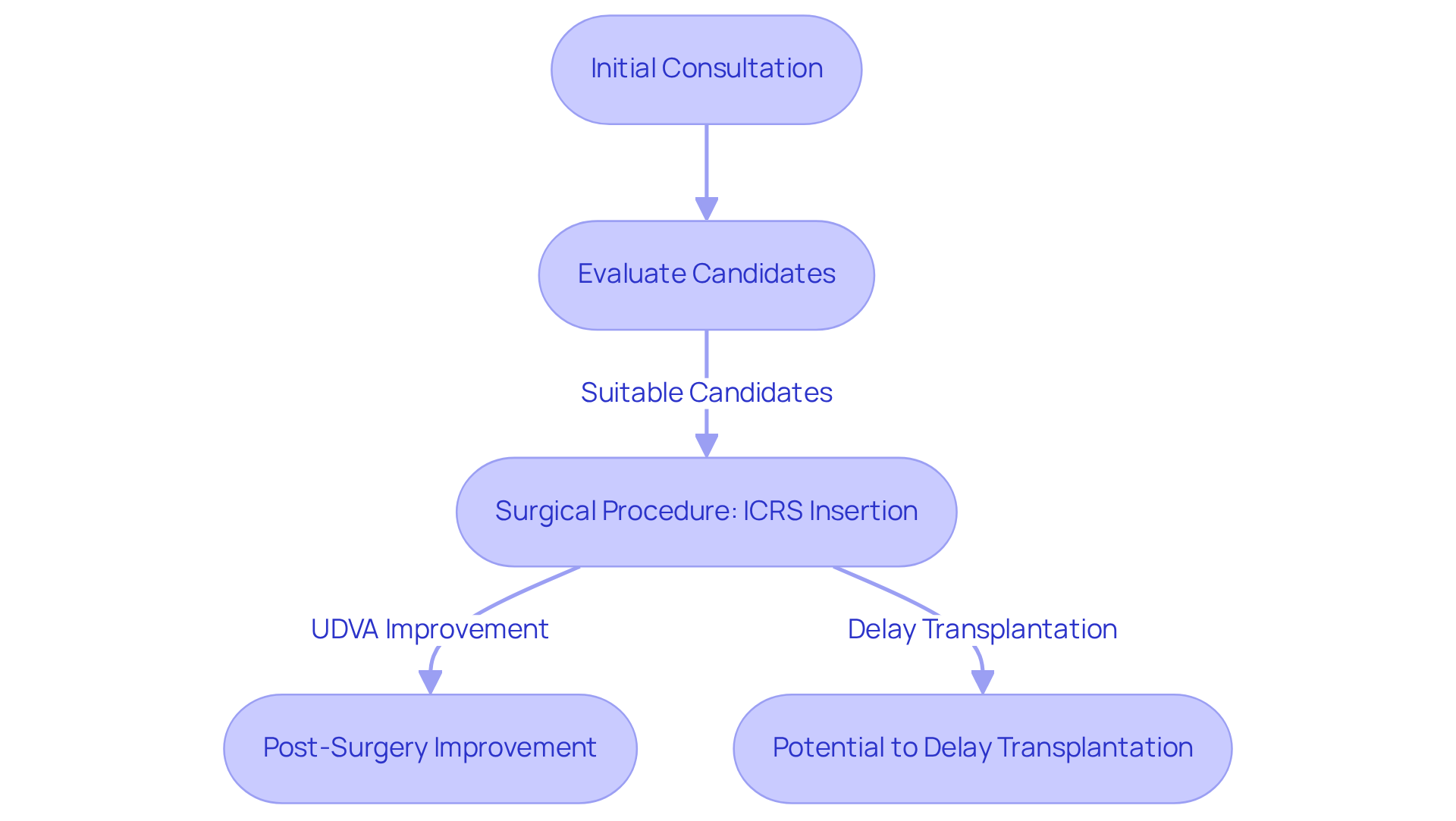
Customized Contact Lenses: Enhancing Vision for Keratoconus Patients
Customized contact optics, especially rigid gas permeable (RGP) and scleral varieties, play a crucial role in managing keratoconus. We understand that navigating this condition can be challenging, and these optical devices are meticulously crafted to fit the distinctive contour of the cornea, greatly improving both sight and comfort.
RGP devices form a smooth optical surface over the irregular cornea, which can lead to significant enhancements in visual clarity. In fact, research has demonstrated that individuals utilizing RGP contacts often report a mean logMAR visual acuity enhancement from 0.50 to 0.08. This emphasizes their effectiveness in correcting vision and provides reassurance to those seeking solutions.
Scleral devices, in contrast, vault over the cornea, offering a fluid reservoir that not only improves comfort but also stabilizes vision. It’s common to feel uncertain about which option to choose, but this design is especially advantageous for individuals with advanced keratoconus, as it permits a more regular refractive surface. Research indicates that scleral devices can enhance best-corrected visual acuity from baseline logMAR 0.50-0.53 to post-treatment logMAR 0.08-0.09, demonstrating their significant impact on quality of life.
Success stories are plentiful, with numerous individuals expressing satisfaction after switching to scleral devices. For example, a 60-year-old female patient with stage 2 corneal ectasia experienced remarkable enhancement in visual clarity after transitioning from RGP contacts to scleral optics. This highlights the significance of personalized fitting and how it can transform lives.
Eye care specialists emphasize that although RGP options continue to be a popular selection, the rising use of scleral products as keratoconus treatments demonstrates their efficacy and comfort in handling corneal irregularities. We are here to help you through this process, ensuring that these specialized lenses become essential parts of a thorough management approach for corneal disease.
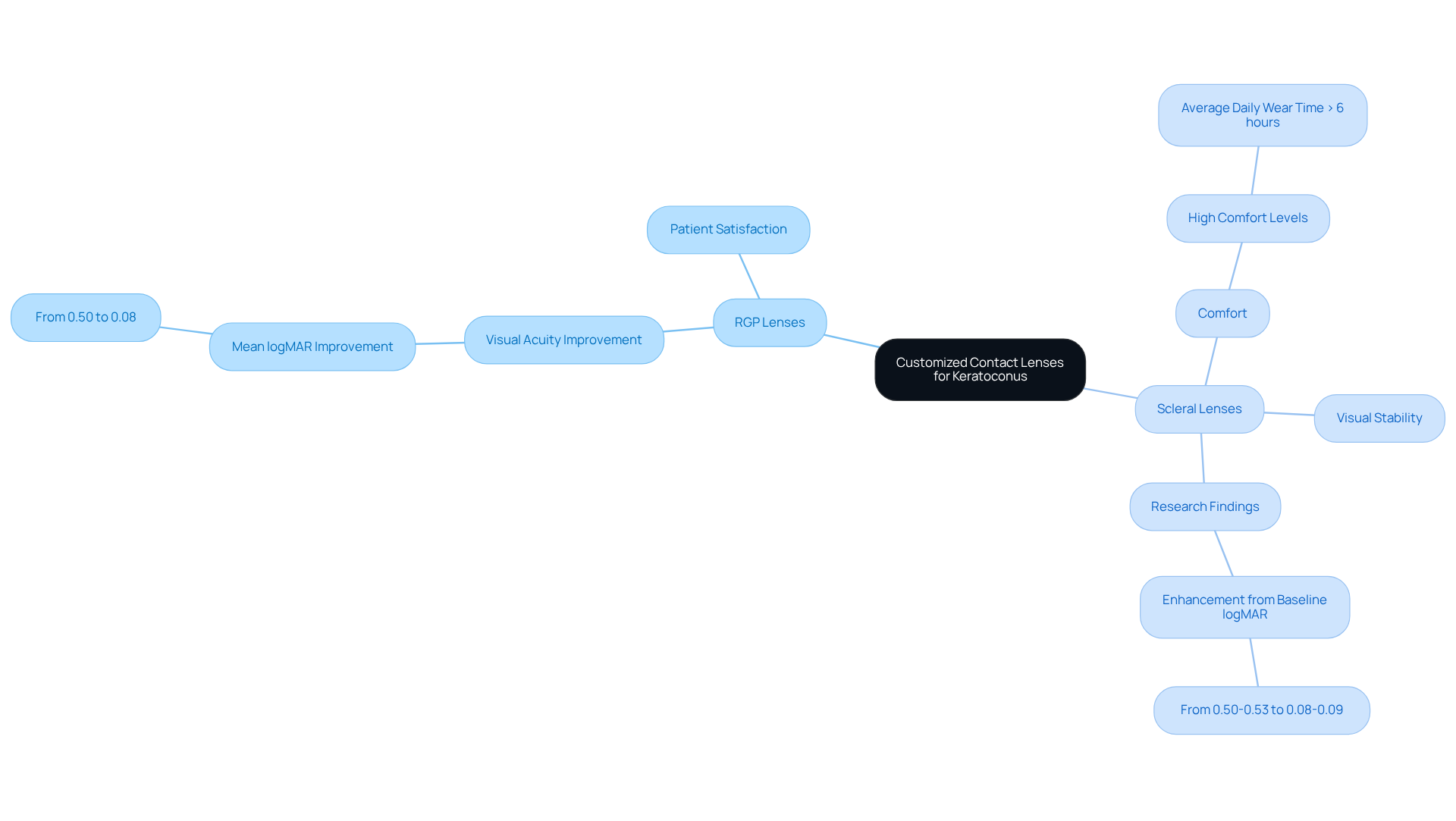
Corneal Transplant Surgery: A Solution for Advanced Keratoconus
For individuals facing advanced corneal disease, we understand that the idea of transplant surgery can feel daunting. The cornea, a transparent dome-shaped layer at the front of your eye, plays a vital role in focusing light and protecting the inner structures of the eye. This procedure involves replacing the damaged cornea with healthy donor tissue, which can significantly restore vision and enhance the integrity of your cornea. There are two primary types of corneal transplants:
- Penetrating keratoplasty (PK), which replaces the entire cornea.
- Deep anterior lamellar keratoplasty (DALK), which selectively replaces only the front layers.
Each technique for keratoconus treatments is chosen based on the severity of keratoconus and your unique needs.
Statistics show that approximately 4 out of 5 individuals achieve driving-standard vision or better within a year following corneal transplantation. In a case series of 3,992 eyes, the graft survival rate for PK was 90% at 5 years and 82% at 10 years. However, we want to emphasize that successful outcomes depend on careful post-operative management, including the use of anti-rejection medications and regular follow-up appointments.
Patient recovery stories highlight the transformative impact of corneal transplants. Many individuals report significant improvements in their quality of life, with some experiencing enhanced vision within weeks of surgery. Surgeons stress the importance of managing possible complications, such as graft rejection, which occurs in approximately 1 in 3 individuals with PK during the initial two years. By following post-operative care protocols—such as taking two weeks off work to aid recovery—you can maximize your chances of a successful recovery and long-term vision restoration.
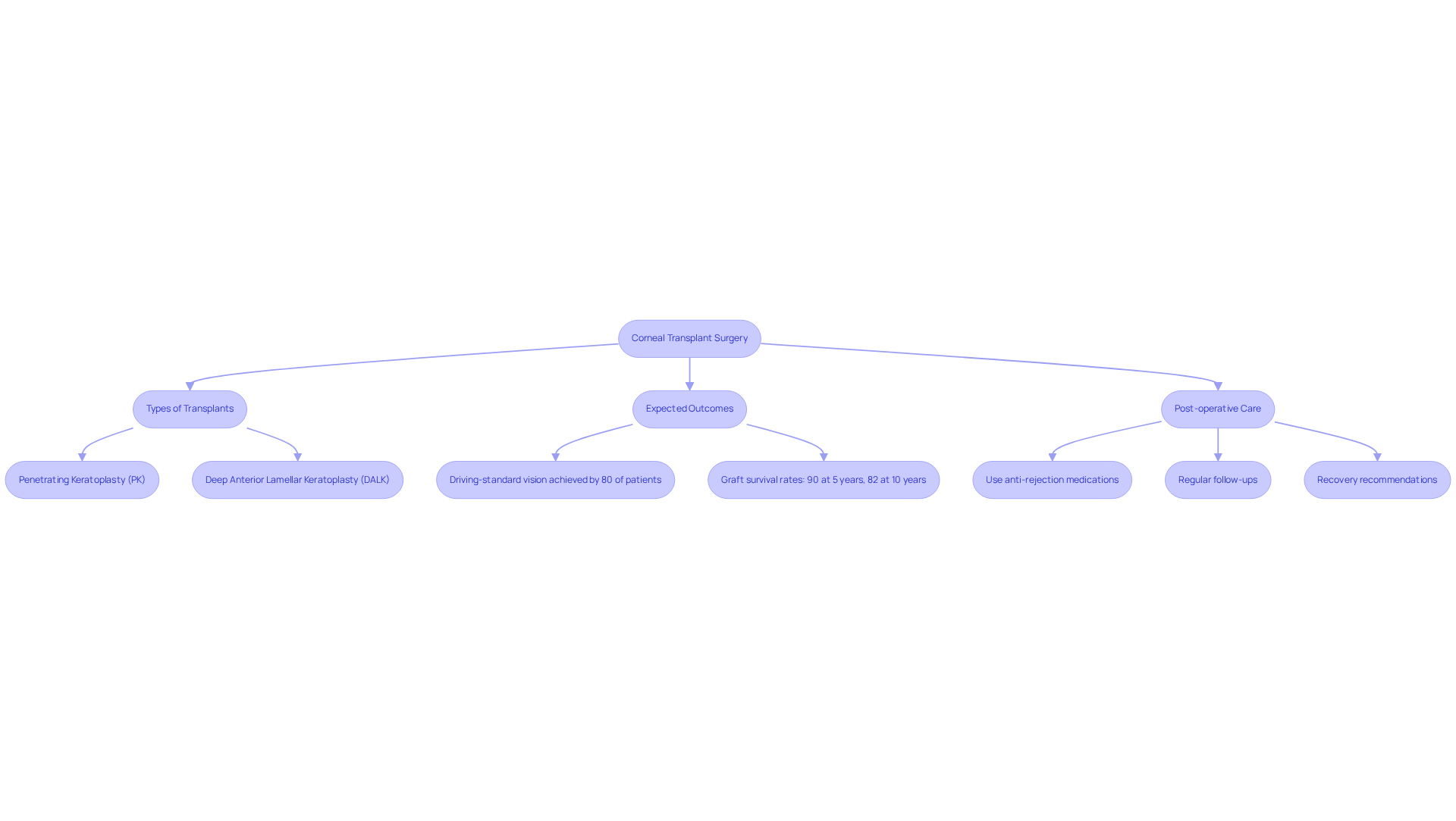
High-Energy Epi-On Cross-Linking: A Less Invasive Approach
High-energy Epi-On Cross-Linking marks a significant advancement in keratoconus treatments, especially in preserving the corneal epithelium during the procedure. We understand that concerns about discomfort and recovery times are common, and this innovative method addresses those worries effectively. By reducing discomfort and accelerating recovery compared to traditional Epi-Off CXL techniques, Epi-On CXL offers a reassuring option for patients.
This technique utilizes riboflavin alongside higher energy UV light to strengthen the cornea while minimizing the risks associated with epithelial removal. Patients often report improved comfort levels and quicker visual recovery, making this method particularly appealing for individuals facing progressive conditions characterized by corneal thinning and irregular curvature, which can lead to blurry or double vision and light sensitivity.
For those experiencing less severe corneal irregularities, specially fitted contact devices may also be recommended to help correct distortion. Research indicates that Epi-On CXL can lead to a decrease in maximum keratometry (Kmax) and enhanced corrected distance visual acuity (CDVA). In fact, Kmax improved in 89 eyes (87%), with 20 eyes (19.6%) showing a reduction of over 2 D.
Eye specialists at Northwest Eye have observed that this method offers a more favorable safety profile, with fewer adverse events reported. This further reinforces its status as a preferred choice for managing corneal conditions through keratoconus treatments. We are here to help you through this process and ensure you receive the best care possible.
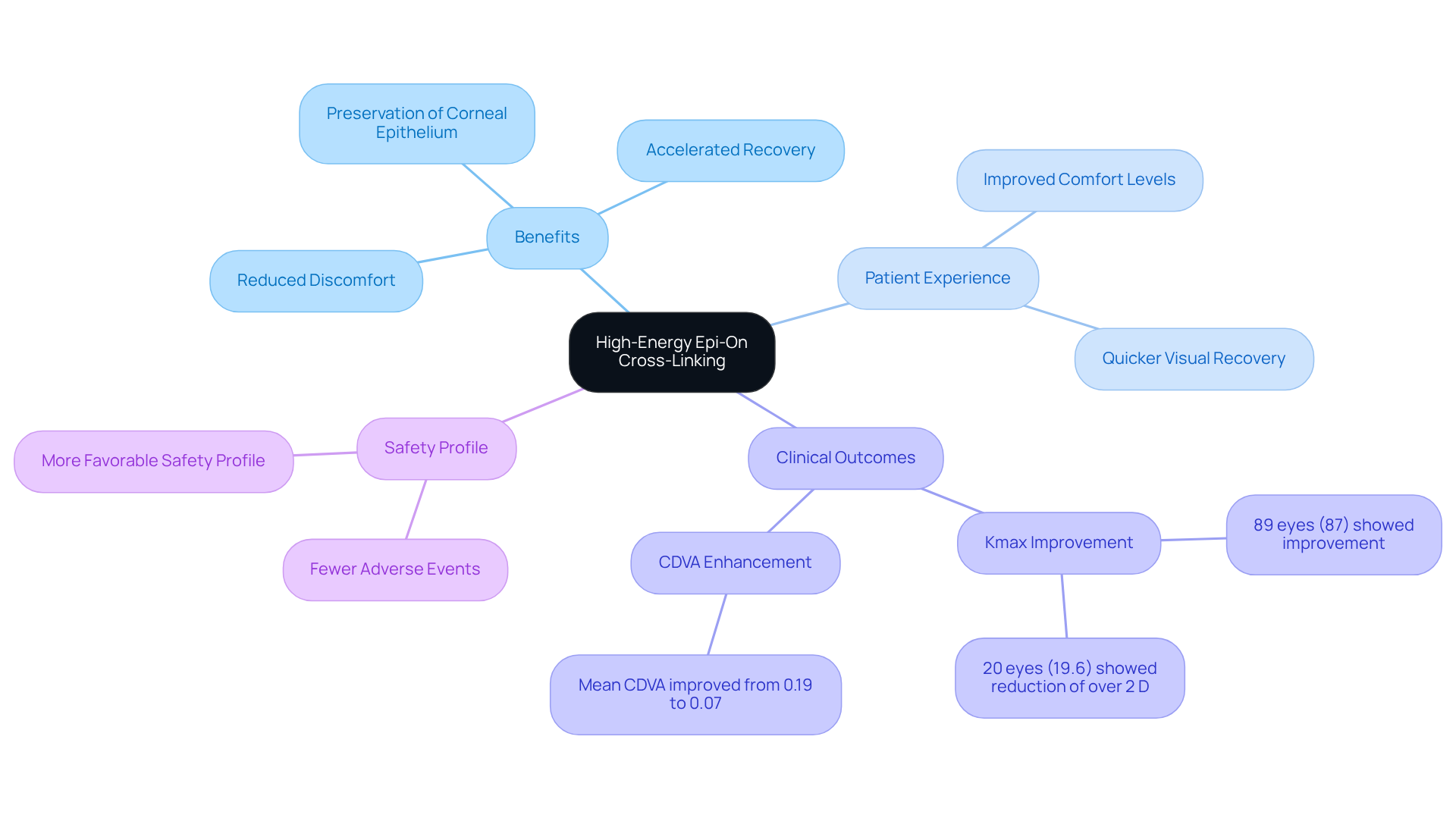
Scleral Lenses: Comfort and Clarity for Keratoconus
Scleral devices are large, gas-permeable products that rest gently on the sclera, arching over the cornea, which is the clear dome-shaped layer at the front of your eye. We understand that managing corneal conditions can be challenging, and these keratoconus treatments provide a sleek visual interface that can greatly enhance your sight.
One of the key advantages of scleral devices is their ability to form a fluid reservoir. This feature not only improves comfort but also protects the cornea from further harm. Given the cornea’s vital role in maintaining eye health, preserving its integrity is crucial. Many individuals find that scleral optics provide enhanced clarity and comfort compared to conventional contact options. This makes keratoconus treatments an ideal choice for effectively managing corneal irregularities.
We are here to help you through this process, ensuring that you feel supported and informed every step of the way.
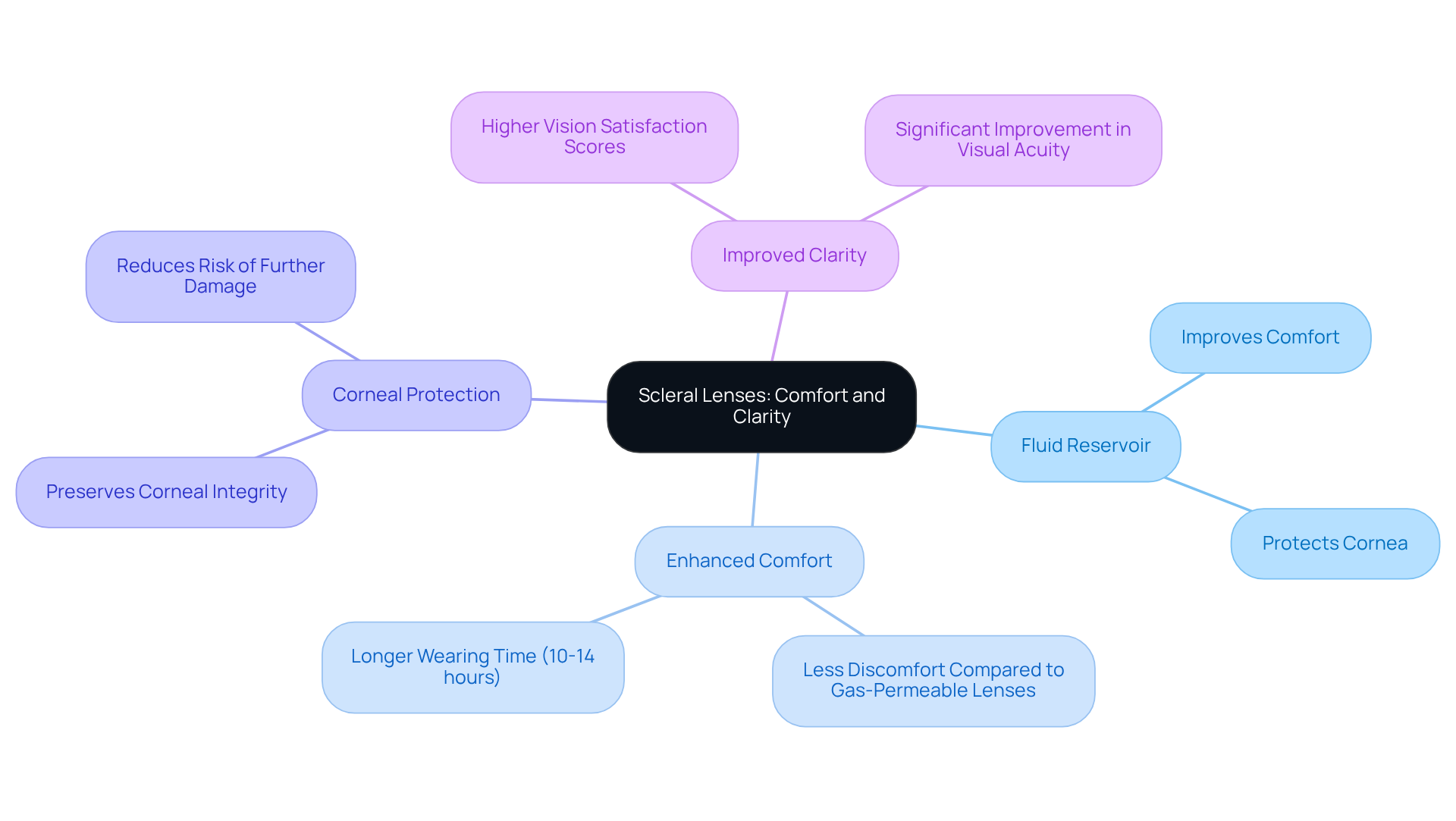
Implantable Collamer Lenses (ICL): Advanced Vision Correction
Implantable Collamer Lenses (ICL) represent a groundbreaking advancement among keratoconus treatments for patients seeking effective vision correction without the need for corneal tissue removal. We understand that navigating vision correction options can be overwhelming, and ICLs offer a compassionate solution. This innovative procedure involves inserting a soft, flexible collamer lens into the eye, providing a permanent solution for various refractive errors. ICLs are particularly advantageous for individuals who may not qualify for LASIK or other laser-based treatments due to corneal irregularities or thickness limitations.
Clinical studies indicate that ICLs yield impressive visual outcomes, with approximately 95% of patients reporting satisfaction with their results. It’s common to feel apprehensive about procedures, but the design of ICLs allows for reversibility, meaning the lens can be removed or replaced if future vision correction is necessary. This flexibility makes ICLs a preferred option for managing corneal conditions, including keratoconus treatments, giving you peace of mind.
Ophthalmologists emphasize the benefits of ICLs, noting that they preserve the natural structure of the eye while effectively correcting vision. Patient testimonials further highlight the positive experiences associated with ICL implantation. Many individuals have shared their stories of significant improvements in visual acuity and overall quality of life. With ICLs, you can attain improved vision stability and comfort, making them a valuable choice in the realm of corneal conditions. We are here to help you through this process, ensuring you feel supported every step of the way.
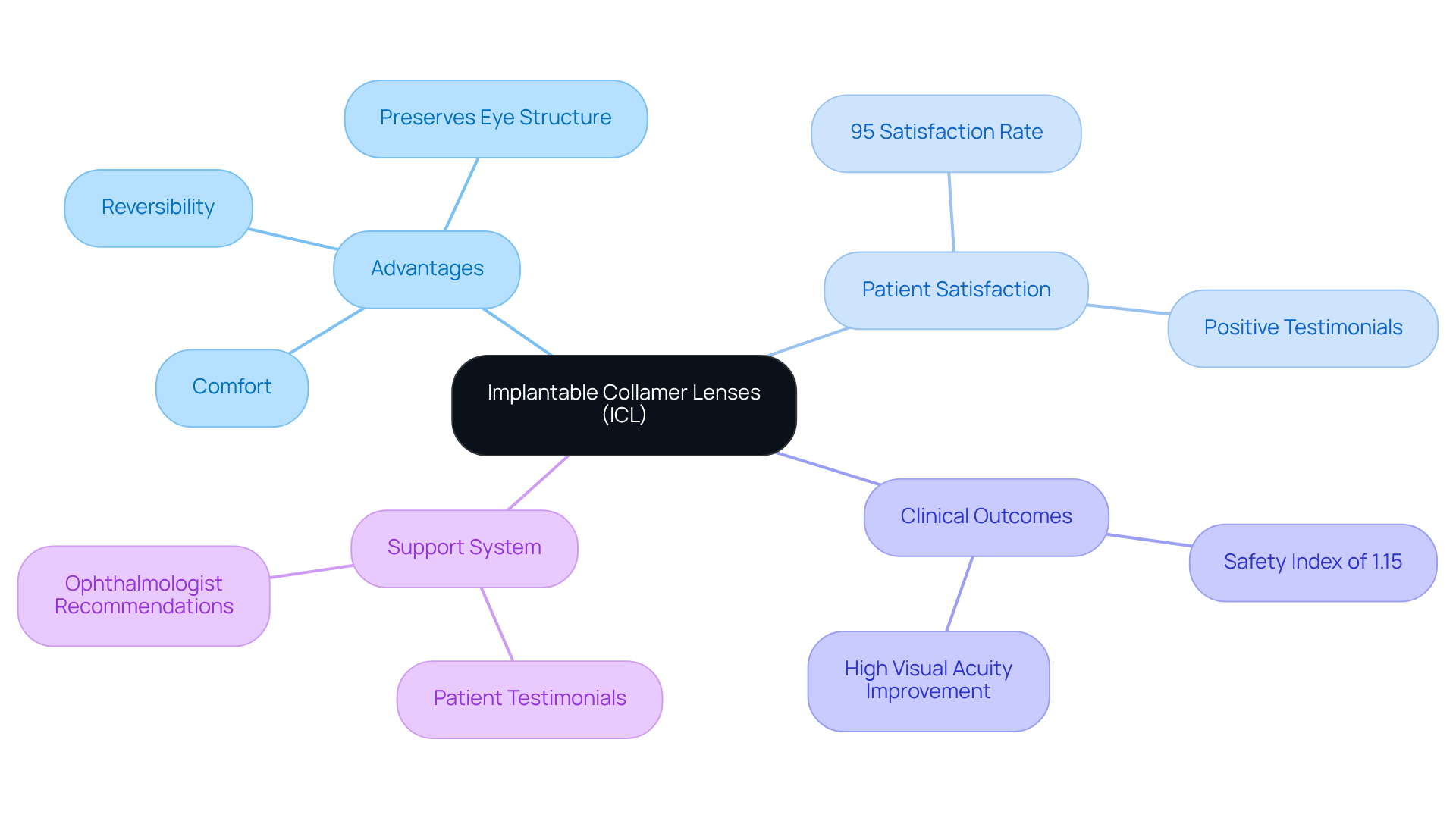
Ongoing Management: Monitoring Keratoconus Progression
Regular monitoring is essential for individuals with keratoconus. We understand that navigating this condition can be challenging, and effective observation of disease progression is crucial for adjusting care plans. Follow-up appointments every 3 to 6 months allow eye care professionals to evaluate corneal shape and thickness, facilitating timely interventions when necessary.
It’s common to feel concerned about the progression of keratoconus. Statistics indicate that approximately 40.7% of patients aged 20 years and younger may experience a ≥1 diopter annual increase in maximum keratometric value (Kmax). This highlights the need for vigilant monitoring and reassures you that regular check-ups are vital.
Advanced imaging techniques, such as corneal topography and epithelial thickness mapping, provide essential insights into corneal changes. These tools allow for informed treatment decisions, ensuring that you receive the best possible care tailored to your needs.
As Yaron S. Rabinowitz, MD, points out, ‘Relatives in a high-risk group may have a greater risk of progression to the condition.’ This emphasizes the necessity of regular follow-ups, especially for those with a family history. We are here to support you in this proactive strategy, which not only improves outcomes but also empowers you to take an active role in your eye health management.
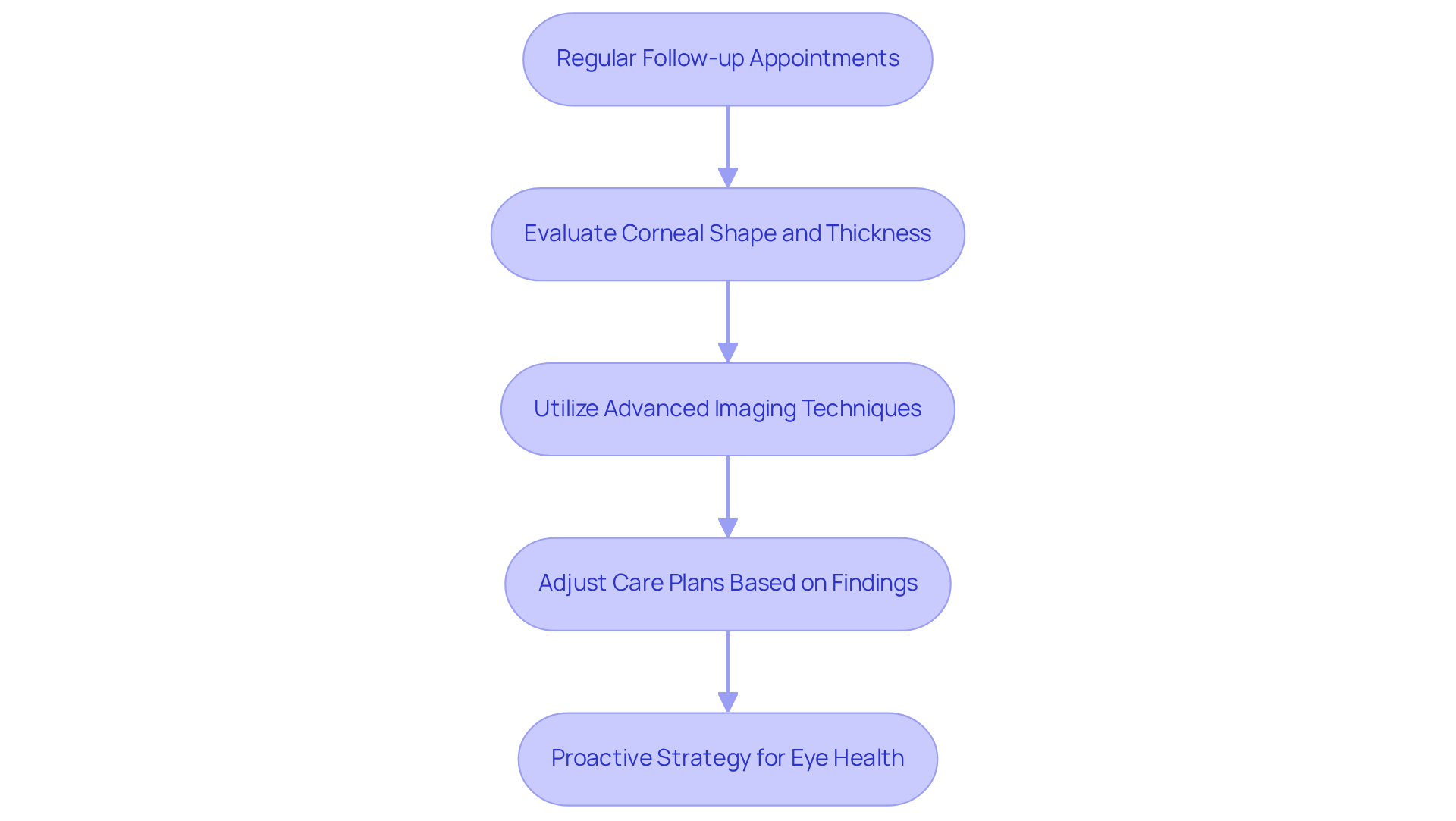
Patient Education and Support: Empowering Keratoconus Patients
Empowering individuals through education is essential to effective keratoconus treatments management. We understand that navigating this condition can be challenging, and Northwest Eye is here to support you. We offer a comprehensive array of resources, including detailed informational materials and access to specialized support groups. These groups play a crucial role in fostering a sense of community and understanding among individuals, allowing you to share experiences and coping strategies.
Research indicates that individuals who engage with educational resources report higher satisfaction levels. In fact, studies show that tailored educational interventions can improve knowledge retention by up to 12%. Moreover, the beneficial effect of healthcare education on health outcomes is well established, with estimates indicating enhancements of up to 50-80%.
Success stories from support groups illustrate their transformative impact; many patients have expressed gratitude for the emotional and practical support received, which has significantly enhanced their quality of life. Specialists emphasize that these groups not only provide emotional backing but also facilitate better communication with healthcare providers. This leads to more informed decision-making regarding keratoconus treatments options. Insights from case studies highlight the emotional difficulties encountered by individuals with this condition, underscoring the significance of support networks in tackling these challenges.
In recent news, the increasing acknowledgment of the significance of support networks in eye care has led to initiatives focused on enhancing access to these resources. This ensures that more individuals with corneal conditions can benefit from shared experiences and collective knowledge. The national prevalence of keratoconus has increased from 0.03% in 2016 to 0.04% in 2019, emphasizing the need for effective management strategies. By fostering an environment of understanding and support, Northwest Eye equips patients to navigate their treatment options effectively, ultimately contributing to improved outcomes and satisfaction.

Conclusion
The journey through keratoconus treatment is marked by the promise of tailored solutions that enhance vision and improve quality of life. With a variety of effective options available—from innovative procedures like corneal cross-linking and intracorneal ring segments to personalized contact lenses and corneal transplants—patients can find the right approach to manage their condition. Each treatment not only addresses the physical aspects of keratoconus but also emphasizes the importance of emotional support and education throughout the process.
Key insights from this exploration highlight the advancements in keratoconus treatments that have emerged over the years. We understand that navigating these options can feel overwhelming. The commitment to personalized care, the effectiveness of customized lenses, and the role of ongoing monitoring underscore the necessity of a comprehensive approach to managing this condition. Furthermore, the integration of patient education and support networks plays a vital role in empowering individuals, fostering a sense of community, and ultimately enhancing treatment satisfaction.
In light of the significant developments in keratoconus care, it is crucial for individuals to remain informed about their options and actively engage with healthcare providers. It’s common to feel uncertain, but by prioritizing regular check-ups and utilizing available resources, patients can navigate their treatment journey with confidence. Embracing these advancements not only leads to better visual outcomes but also cultivates a supportive environment that encourages resilience and hope for those affected by keratoconus.
Frequently Asked Questions
What is keratoconus and how does Northwest Eye address it?
Keratoconus is a corneal condition characterized by thinning and abnormal curvature of the cornea. Northwest Eye offers a comprehensive range of tailored treatments for keratoconus, utilizing advanced technology and a patient-focused approach to enhance vision and improve quality of life.
What recent advancements have been made in keratoconus treatments?
Recent advancements in keratoconus treatments have significantly improved patient outcomes. The corneal condition care market is projected to grow, driven by increased awareness and technological innovations.
What is the significance of personalized care in keratoconus treatment?
Personalized care is crucial as it aligns treatment options with individual patient objectives. This approach not only addresses medical aspects but also provides emotional support, especially for younger patients facing chronic illness.
What treatments does Northwest Eye offer for keratoconus?
Northwest Eye offers several treatments for keratoconus, including corneal cross-linking (CXL) and personalized contact lenses, which stabilize the condition and enhance visual clarity.
What is Corneal Cross-Linking (CXL)?
CXL is a minimally invasive procedure designed to strengthen the cornea by applying riboflavin drops followed by ultraviolet light exposure, which helps form new bonds between collagen fibers, improving corneal stability and visual clarity.
What are the success rates for Corneal Cross-Linking?
Studies show that 84.1% of individuals who underwent CXL maintained good visual acuity in their better eye after ten years. Accelerated CXL has a failure rate of only 14.7%.
What are Intracorneal Ring Segments (ICRS)?
ICRS are crescent-shaped devices surgically inserted into the cornea to flatten and reshape it, improving visual clarity for individuals with corneal irregularities.
Who is a suitable candidate for ICRS?
ICRS is suitable for individuals with moderate keratoconus who may not be candidates for other treatments or are seeking additional vision correction.
What are the benefits of ICRS?
ICRS can enhance contact lens tolerance, improve uncorrected distance visual acuity, and potentially delay or prevent the need for corneal transplantation in advanced cases.
How does Northwest Eye ensure patient support during treatment?
Northwest Eye prioritizes both physical and emotional well-being, providing support throughout the treatment process to ensure patients feel reassured and informed.






